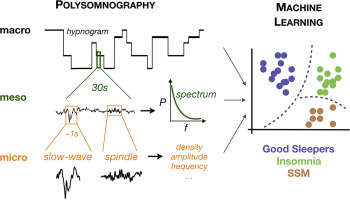当前位置:
X-MOL 学术
›
Sleep Med.
›
论文详情
Our official English website, www.x-mol.net, welcomes your
feedback! (Note: you will need to create a separate account there.)
Revisiting the value of polysomnographic data in insomnia: more than meets the eye.
Sleep Medicine ( IF 3.8 ) Pub Date : 2019-12-13 , DOI: 10.1016/j.sleep.2019.12.002 Thomas Andrillon 1 , Geoffroy Solelhac 2 , Paul Bouchequet 2 , Francesco Romano 2 , Max-Pol Le Brun 3 , Marco Brigham 3 , Mounir Chennaoui 4 , Damien Léger 2
Sleep Medicine ( IF 3.8 ) Pub Date : 2019-12-13 , DOI: 10.1016/j.sleep.2019.12.002 Thomas Andrillon 1 , Geoffroy Solelhac 2 , Paul Bouchequet 2 , Francesco Romano 2 , Max-Pol Le Brun 3 , Marco Brigham 3 , Mounir Chennaoui 4 , Damien Léger 2
Affiliation

|
BACKGROUND
Polysomnography (PSG) is not recommended as a diagnostic tool in insomnia. However, this consensual approach might be tempered in the light of two ongoing transformations in sleep research: big data and artificial intelligence (AI).
METHOD
We analyzed the PSG of 347 patients with chronic insomnia, including 59 with Sleep State Misperception (SSM) and 288 without (INS). 89 good sleepers (GS) were used as controls. PSGs were compared regarding: (1) macroscopic indexes derived from the hypnogram, (2) mesoscopic indexes extracted from the electroencephalographic (EEG) spectrum, (3) sleep microstructure (slow waves, spindles). We used supervised algorithms to differentiate patients from GS.
RESULTS
Macroscopic features illustrate the insomnia conundrum, with SSM patients displaying similar sleep metrics as GS, whereas INS patients show a deteriorated sleep. However, both SSM and INS patients showed marked differences in EEG spectral components (meso) compared to GS, with reduced power in the delta band and increased power in the theta/alpha, sigma and beta bands. INS and SSM patients showed decreased spectral slope in NREM. INS and SSM patients also differed from GS in sleep microstructure with fewer and slower slow waves and more and faster sleep spindles. Importantly, SSM and INS patients were almost indistinguishable at the meso and micro levels. Accordingly, unsupervised classifiers can reliably categorize insomnia patients and GS (Cohen's κ = 0.87) but fail to tease apart SSM and INS patients when restricting classifiers to micro and meso features (κ=0.004).
CONCLUSION
AI analyses of PSG recordings can help moving insomnia diagnosis beyond subjective complaints and shed light on the physiological substrate of insomnia.
中文翻译:

重温多导睡眠图数据在失眠中的价值:不只是让人眼前一亮。
背景技术不建议将多导睡眠图(PSG)作为失眠的诊断工具。但是,可以根据睡眠研究中的两个正在进行的转变来缓和这种协商一致的方法:大数据和人工智能(AI)。方法我们分析了347例慢性失眠患者的PSG,其中包括59例睡眠状态错误(SSM)和288例(INS)失眠。使用89个良好的睡眠者(GS)作为对照。比较PSG的以下方面:(1)从催眠图得出的宏观指标;(2)从脑电图(EEG)谱中提取的介观指标;(3)睡眠微观结构(慢波,纺锤体)。我们使用监督算法来区分患者与GS。结果宏观特征说明了失眠难题,SSM患者的睡眠指标与GS类似,而INS患者表现出睡眠恶化。但是,与GS相比,SSM和INS患者在EEG频谱成分(中观)上均表现出显着差异,δ带的能量降低,θ/α,sigma和β带的能量增加。INS和SSM患者的NREM频谱斜率降低。INS和SSM患者在睡眠微观结构上也与GS不同,其慢波较少且较慢,睡眠纺锤较多且较快。重要的是,SSM和INS患者在中观和微观水平上几乎是无法区分的。因此,无监督分类器可以将失眠患者和GS可靠地分类(Cohenκ= 0.87),但在将分类器限制为微观和中观特征时(κ= 0.004),无法区分SSM和INS患者。
更新日期:2019-12-17
中文翻译:

重温多导睡眠图数据在失眠中的价值:不只是让人眼前一亮。
背景技术不建议将多导睡眠图(PSG)作为失眠的诊断工具。但是,可以根据睡眠研究中的两个正在进行的转变来缓和这种协商一致的方法:大数据和人工智能(AI)。方法我们分析了347例慢性失眠患者的PSG,其中包括59例睡眠状态错误(SSM)和288例(INS)失眠。使用89个良好的睡眠者(GS)作为对照。比较PSG的以下方面:(1)从催眠图得出的宏观指标;(2)从脑电图(EEG)谱中提取的介观指标;(3)睡眠微观结构(慢波,纺锤体)。我们使用监督算法来区分患者与GS。结果宏观特征说明了失眠难题,SSM患者的睡眠指标与GS类似,而INS患者表现出睡眠恶化。但是,与GS相比,SSM和INS患者在EEG频谱成分(中观)上均表现出显着差异,δ带的能量降低,θ/α,sigma和β带的能量增加。INS和SSM患者的NREM频谱斜率降低。INS和SSM患者在睡眠微观结构上也与GS不同,其慢波较少且较慢,睡眠纺锤较多且较快。重要的是,SSM和INS患者在中观和微观水平上几乎是无法区分的。因此,无监督分类器可以将失眠患者和GS可靠地分类(Cohenκ= 0.87),但在将分类器限制为微观和中观特征时(κ= 0.004),无法区分SSM和INS患者。











































 京公网安备 11010802027423号
京公网安备 11010802027423号